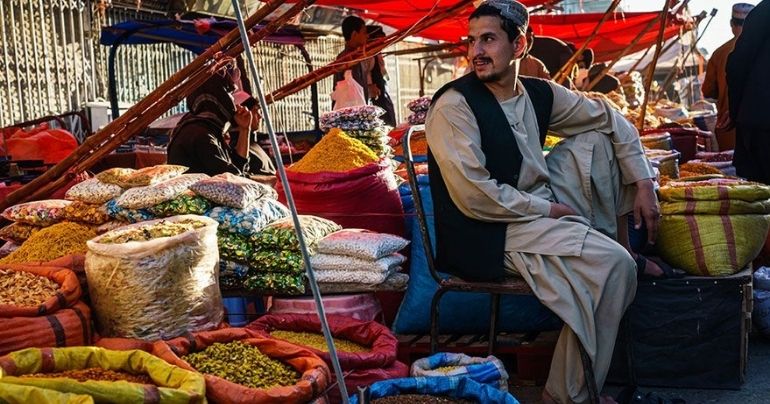US and Nato troops are finally withdrawing from Afghanistan after 20 years of war. The Taliban, who they came to defeat, are rapidly retaking territory across the country.
How has the war changed Afghanistan, and what comes next?
Are the Taliban back?
The Taliban – a fundamentalist Islamist militia – were forced from power when US-led forces invaded in 2001. Democratic presidential elections and a new constitution were established, but the Taliban waged a long insurgency, gradually regaining strength and drawing more US and Nato forces into the conflict.
Now, as the US withdraws the last of its troops, the group is retaking many districts, reimposing their strict form of Sharia law.
The BBC Afghan service confirmed the situation across the country on 12 July – verifying which areas were under Taliban or government control.
The areas marked as contested are where fighting is happening or the Taliban have a strong presence in parts of the district.
The situation on the ground is fluid, and restricted access to some parts of the country make it difficult to verify reports, but it is clear that the Taliban are making significant gains. They are thought to now control about a third of the country.
How many people have died since 2001?
Twenty years of fighting have left thousands of fighters dead on both sides in Afghanistan and across the border in neighbouring Pakistan. Civilians have also been caught up in the conflict – dying in coalition air strikes and targeted attacks by the Taliban.
The number of civilians killed in the first three months of 2021 was “significantly higher” than a year ago, an increase attributed by the United Nations to the use of improvised explosive devices – IEDs – and targeted killings.
Women and children made up 43% of civilian casualties in Afghanistan in 2020.
How many have fled the fighting?
Years of conflict have forced millions to flee their homes, some taking refuge in neighbouring countries or seeking asylum further afield. Many have been left displaced and homeless within Afghanistan, alongside millions facing hardship and hunger.
Last year, more than 400,000 people were displaced by conflict. Since 2012, around five million people have fled and not been able to return home. According to the UN’s human rights agency, Afghanistan has the third largest displaced population in the world.
The coronavirus pandemic has placed an additional strain on Afghanistan’s nationwide resources, and lockdowns and movement restrictions have had an impact on many people’s ability to earn money – especially in rural areas.
According to the UN’s Office for Humanitarian Affairs, more than 30% of the population are facing emergency or crisis levels of food insecurity.
Can girls go to school now?
The fall of the Taliban regime allowed some significant change and progress in term of women’s rights and education. Back in 1999, there was not a single girl enrolled in a secondary school and only 9,000 were at primary schools.
By 2003, 2.4 million girls were in school. That figure is now around 3.5 million, and around a third of students at public and private universities are women.
But according to the children’s charity Unicef, there are still more than 3.7 million children out of school and 60% of them are girls, mainly due to the ongoing conflict and lack of adequate teaching facilities and women teachers.
The Taliban say that they no longer oppose girls’ education, but according to Human Rights Watch very few Taliban officials in the areas they control actually allow girls to attend school past puberty.
More opportunities for women
Women are also participating in public life, holding political office and pursuing business opportunities. More than 1,000 Afghan women had started their own businesses by 2019 – all activities that would have been prohibited under the Taliban.
The constitution now dictates that women should hold at least 27% of seats in the lower house of parliament, and they are currently slightly exceeding that with 69 of the 249 seats.
How else has life changed?
Access to a mobile phones and the internet is growing, despite many other infrastructure issues across the country.
More than 8.6 million people – around 22% of the population – had access to the internet in January 2021 and millions now use social media.
Mobile phone usage also continues to grow – with about 68% of people now owning a mobile phone. But according to the UN, sporadic outages of mobile service continue to affect communication.
Many people in Afghanistan do not have a bank account – around 80% of adults, which is higher than average for low income countries. As well as security concerns, the World Bank says this is mainly due to religious and cultural beliefs, a lack of trust in the financial sector, and low rates of financial literacy.
However, the bank expects new projects will help double the percentage of Afghan adults owning bank accounts in the next five years.
In the capital, Kabul, where traditional adobe houses line the hillsides, the city skyline has changed over the past 20 years, with clusters of high rise buildings going up. to accommodate a ballooning city population.
Kabul saw rapid urbanisation in the years after the Taliban fell, as people moved in from rural districts where fighting continued, and Afghans who fled the Taliban in the 1990s returned home from Pakistan and Iran.
Opium central to rural economy
Afghanistan remains the world’s largest producer of opiates, and British officials estimate that about 95% of heroin that arrives in the UK originates in Afghanistan.
According to UN figures, poppy cultivation in Afghanistan has increased significantly in the past 20 years, and only 12 of the country’s 34 provinces remain free of poppy cultivation.
This is despite targeted eradication programmes and incentives for farmers to switch to crops such as pomegranates or saffron.
Although the Taliban enforced a short-lived ban on poppy farming in 2001, it has since become a multi-million dollar source of income for them and others. Poppy farmers are often forced to pay taxes on their earnings to the militants.
Political instability, insecurity and too few employment opportunities are seen as the main drivers for increased poppy production.
SOURCE: BBC











Leave a Comment